Results 11 to 20 of 26
-
12-01-2012, 05:39 PM #11
 W. Greaves & Son Goes back On The Line.
W. Greaves & Son Goes back On The Line.
Looks like the combs my grandmother had of turtle shell! Very nice! Get her shaving! Double O
-
The Following User Says Thank You to Double0757 For This Useful Post:
Hirlau (12-01-2012)
-
12-01-2012, 05:46 PM #12
 W. Greaves & Son Goes back On The Line.
W. Greaves & Son Goes back On The Line.
From: http://reviews.ebay.com/TORTOISESHEL...00000012067858
Care of turtle shell.
Avoid storing tortoiseshell in conditions of excessive heat, humidity or dryness. Turtle shell objects should not be exposed to direct sunlight for any extended period as this can cause them to take on an unattractive greyish hue as the surface moisture dries out.
Turtle shell objects should not be immersed in water, as this will remove the polish. Placing the item in hot water will leave the surface looking dull and pitted and the polish can only be restored by re-buffing. Dirt and finger marks can usually be removed by a simple wipe over with a damp cloth and then a careful polish and dry.
Another hazard for shell combs and those in other materials is the residue left from sticky labels. This can be removed with a small amount of white spirit (turpentine) or piece of impregnated wadding which are sold for cleaning metal jewellery. Following removal the area should be carefully cleaned and polished.
Cleaning with any kind of alcohol or spirit (such as methylated spirits or methanol) should be avoided as this tends to draw the natural oils from the surface and leave it dull and lustreless. The use of aerosol polishes containing silicone should also be avoided as these are not suitable for turtle shell. A light wax such as beeswax is suitable for preserving the shine of shell combs.
Shell combs are often discovered in a dull and scuffed condition. Some conservators recommend soaking in light vegetable oil to restore the natural moisture of objects whose surface has lost their lustre. This should be followed by a vigorous buffing with chamois leather or soft lint free. This will restore much of the surface shine and help to disguise light scratches. However deep scratches or nicks will always be visible when the polished surface is held in a certain light.
Enjoy Double O
-
The Following 2 Users Say Thank You to Double0757 For This Useful Post:
Hirlau (12-01-2012), TrilliumLT (12-01-2012)
-
12-01-2012, 06:21 PM #13Senior Member


- Join Date
- Jan 2011
- Location
- Roseville,Kali
- Posts
- 10,432
Thanked: 2027
I think T also,very nice pce.
-
The Following User Says Thank You to pixelfixed For This Useful Post:
Hirlau (12-01-2012)
-
12-01-2012, 06:22 PM #14
 Re: W. Greaves & Son Goes back On The Line.
Re: W. Greaves & Son Goes back On The Line.
I'm a little bit jealous, I've been looking for some real tortoise scales on a nice razor.
When the Dude is recognized in the world, unDudeness will be seen everywhere--- the Dude de Ching
-
The Following User Says Thank You to maddafinga For This Useful Post:
Hirlau (12-01-2012)
-
12-01-2012, 06:43 PM #15Historically Inquisitive



- Join Date
- Aug 2011
- Location
- Upstate New York
- Posts
- 5,782
- Blog Entries
- 1
Thanked: 4249
Very nice transformation Indeed great work! I would never think grom the first pic that the scales are tortoise. Enjoy!
Might want to try this:
Being made from living animal plates of genuine shell exhibit growth rings and variations of colouration which produce the random mottled patterns which are characteristic of the material. When examined under a microscope or good quality loupe genuine turtle shell has an unmistakable three dimensional quality which is impossible for even the most skilfully made synthetics to imitate exactly.
-
The Following User Says Thank You to Martin103 For This Useful Post:
Hirlau (12-01-2012)
-
12-01-2012, 06:53 PM #16The First Cut is the Deepest!


- Join Date
- Feb 2010
- Location
- Upper Middle Slobovia NY
- Posts
- 2,736
Thanked: 480
its so very hard to differentiate turtle from horn. Both were processed in such a similar matter.
my guess would be turtle, but without holding it in my hands, I could never say for sure (even then my opinion would be suspect!) Either way, fantastic job on the clean up!
-
The Following User Says Thank You to Magpie For This Useful Post:
Hirlau (12-01-2012)
-
12-01-2012, 07:46 PM #17

My guess is Horn. A blonde or honey color. The horn that I've worked on has the same grain as it's essentially hair. Just now I grabbed an old scale, sanded, sanded,sanded and the grains were still there. Only once I polished it did they disappear as you can see in the photos. Also, I shot three pieces in blonde horn. The bottom two haven't been touched and exhibit the same graining, but the top one polished out just fine.
I also included two of my W&Bs in genuine tortoise shell. Working on these they didn't show the same graining patters of the horn. They instead almost appeared as if they were layers on layers ( some separation can still be seen along the edges)
I also included some slabs of honey horn showing the mottled look that can be found in it and as you can see by the one pic, it too will appear yellowish with the streaking and will ultimately be translucent as well.
Chances are as well that if you touch a hot pin to the inside of the scale, it'll smell like burning hair.
Just my .02 worth.
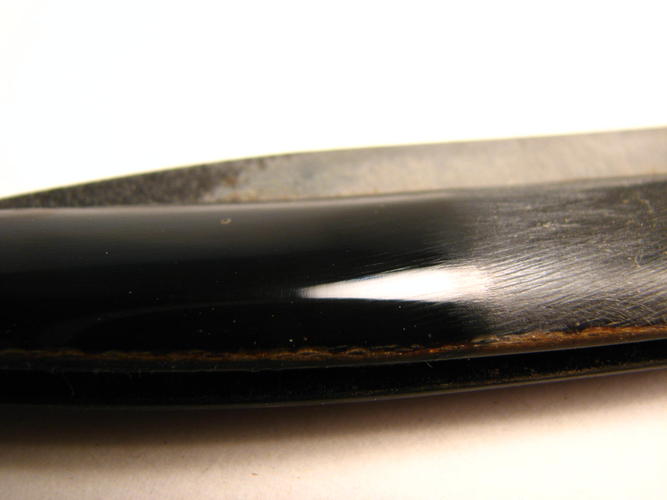
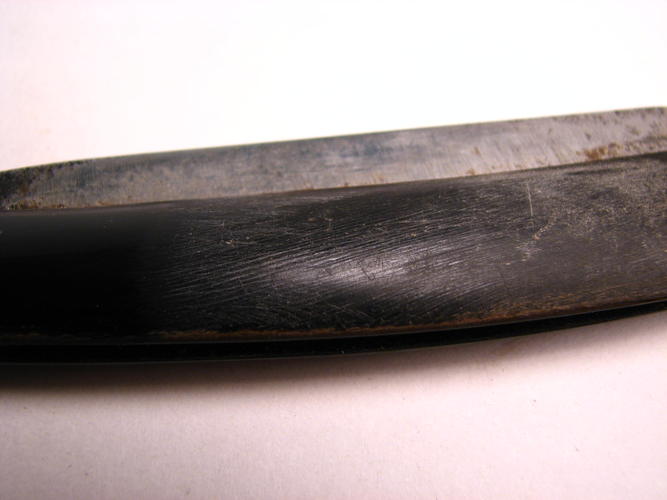

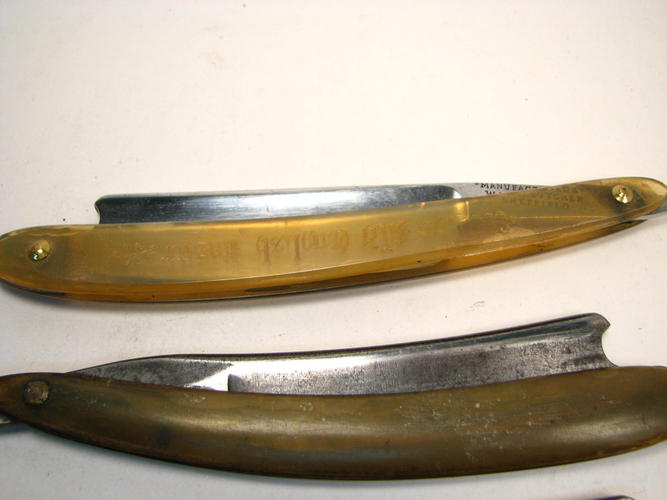
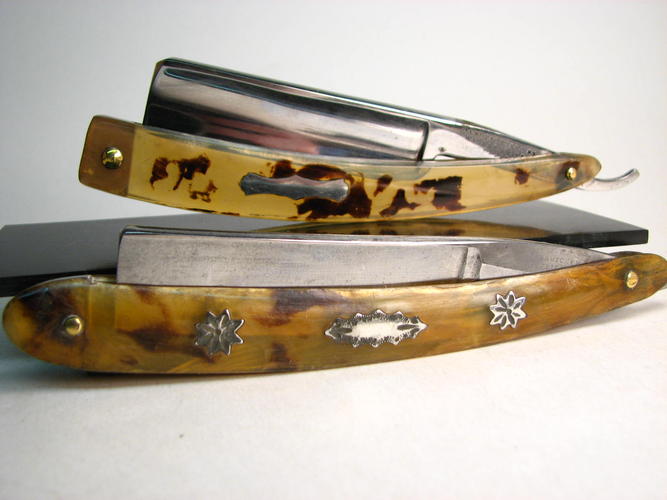
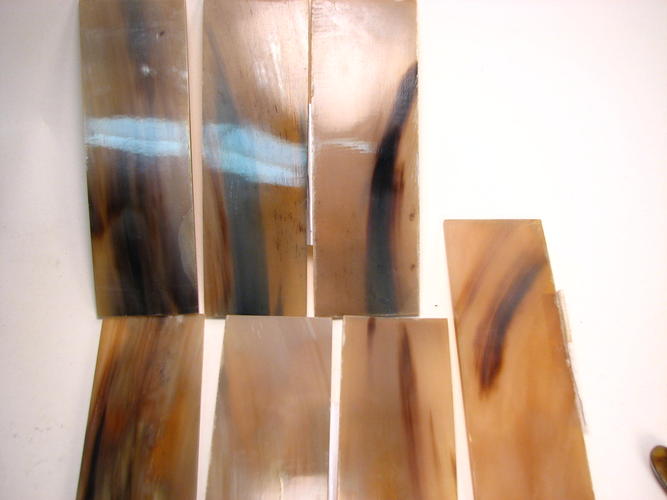
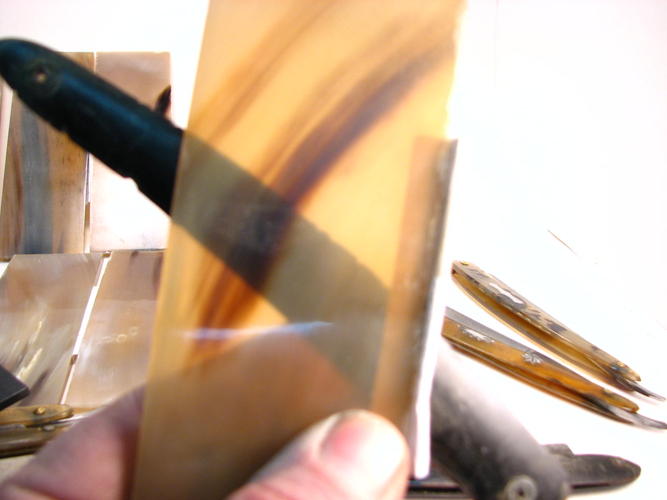
Last edited by mycarver; 12-01-2012 at 07:48 PM.
-
The Following User Says Thank You to mycarver For This Useful Post:
skipnord (12-01-2012)
-
12-01-2012, 07:59 PM #18Senior Member


- Join Date
- Jan 2011
- Location
- Roseville,Kali
- Posts
- 10,432
Thanked: 2027
Nice looking stuff guys,if you do the hot pin test and it smell like fish,than it may be Tortoise

-
The Following User Says Thank You to pixelfixed For This Useful Post:
Hirlau (12-01-2012)
-
12-01-2012, 08:41 PM #19
 W. Greaves & Son Goes back On The Line.
W. Greaves & Son Goes back On The Line.
The only thing with the test is that you would mark the scales with the hot pin. Read thru the link I send you and use a loop to see if you can tell the difference from painted horn vs. real turtle. I think is real, but would need to see it in person to give you a better opinion, with my limited knowledge of shell.
Either way it looks very good! Double OLast edited by Double0757; 12-01-2012 at 08:44 PM.
-
The Following User Says Thank You to Double0757 For This Useful Post:
Hirlau (12-01-2012)
-
12-01-2012, 10:04 PM #20

Well the test would be done on the inside of the scales , and after doing mine, it leaves a negligible mark. But the test isn't conclusive because they'd both smell essentially the same. Basically the same material as is our hair or nails.
At one time horn was used quite a bit to imitate tortoise shell by having artists paint it. The way to conclusively tell would be to cut the scales and see just how the colors are in/on the surface or go through. Although a mottled horn would act the same but the pigments are dispersed differently. The other thing is, shell grows in concentric circles as the shells get larger and I don't believe the first photos show this but rather the long grains associated with horn.
-
The Following User Says Thank You to mycarver For This Useful Post:
Hirlau (12-02-2012)


 28Likes
28Likes LinkBack URL
LinkBack URL About LinkBacks
About LinkBacks






 Reply With Quote
Reply With Quote
